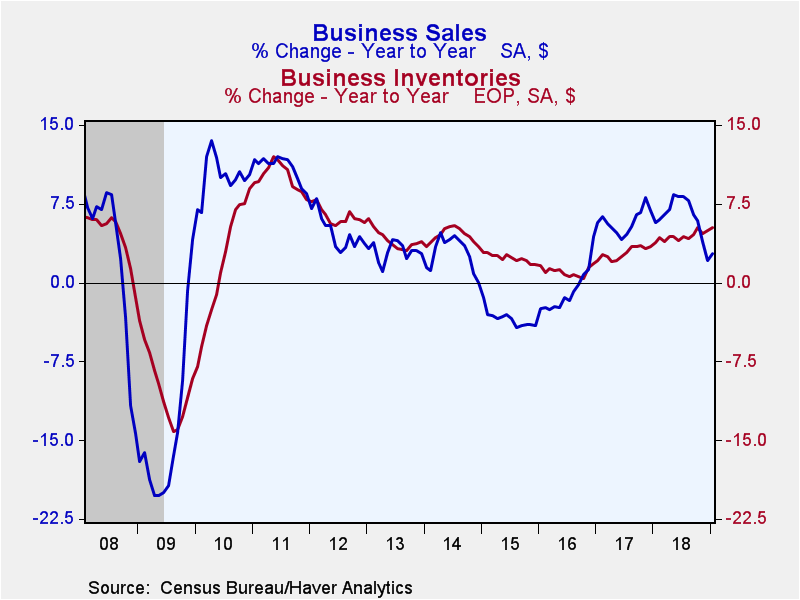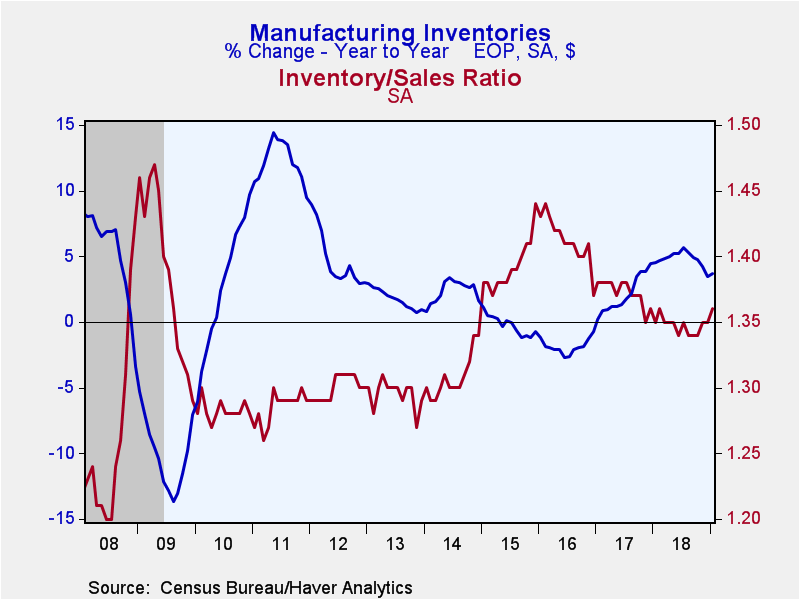 Global| Apr 01 2019
Global| Apr 01 2019U.S. Business Inventories and Sales Rise in January
Summary
Total business inventories increased 0.8% (5.3% year-on-year) during January, the second consecutive monthly gain of this magnitude (this report was delayed as a result of the government shutdown). Total business sales rose 0.3% (2.8% [...]
Total business inventories increased 0.8% (5.3% year-on-year) during January, the second consecutive monthly gain of this magnitude (this report was delayed as a result of the government shutdown). Total business sales rose 0.3% (2.8% y/y), following a 0.9% decrease in December. The inventory-to-sales (I/S) ratio ticked up to 1.39, the fourth consecutive gain. The I/S ratio had declined to 1.33 in mid-2018. Business inventory swings can have a meaningful impact on GDP. In the second and third quarters of 2018 changes in inventories subtracted 1.2 percentage points and then added 2.3 ppt respectively. In Q4, inventories provided just a 0.1 percentage point boost.
Retail inventories increased 0.8% (4.6% y/y) in January after a 1.1% rise. Auto inventories, which comprise roughly 35% of retail inventories, grew 1.2% (9.7% y/y). Non-auto retail inventories rose 0.6% (1.8% y/y). General merchandise inventories, the second largest sector, gained 0.9% (0.5% y/y). The troubled department store sector -- a subset of general merchandise -- saw inventories decline 0.4% (-6.3% y/y); inventories plummeted a record 5.3% in November (data goes back to 1992). As reported the week before last, wholesale inventories grew 1.2% (7.7% y/y). Factory sector inventories rose 0.5% (3.7% y/y).
Retail sales rose an upwardly-revised 0.8% in January (2.6% y/y) with non-auto sales growing 1.6% (3.2% y/y). Note: the advanced retail sales data for February was released today showing a 0.2% decline (+2.1% y/y). Wholesale sector sales increased 0.5% (2.7% y/y), while shipments from the factory sector decreased 0.4% (+3.0% y/y), the fourth consecutive monthly decline.
The inventory-to-sales ratio in the retail sector was unchanged at 1.47 in January. The non-auto I/S ratio ticked down to 1.20, slightly above the historic low of 1.17 reached in November 2018 (data goes back to 1967). The wholesale sector I/S ratio increased to 1.34, its highest level since mid-2016. The manufacturing sector I/S ratio edged up to 1.36.
The manufacturing and trade data are in Haver's USECON database.
| Manufacturing & Trade | Jan | Dec | Nov | Jan Y/Y | 2018 | 2017 | 2016 |
|---|---|---|---|---|---|---|---|
| Business Inventories (% chg) | 0.8 | 0.8 | 0.0 | 5.3 | 5.0 | 3.4 | 1.8 |
| Retail | 0.8 | 1.1 | -0.4 | 4.6 | 4.2 | 2.4 | 4.1 |
| Retail excl. Motor Vehicles | 0.6 | 1.3 | -0.9 | 1.8 | 1.2 | 2.2 | 1.9 |
| Merchant Wholesalers | 1.2 | 1.1 | 0.4 | 7.7 | 7.3 | 3.4 | 2.2 |
| Manufacturing | 0.5 | 0.1 | -0.1 | 3.7 | 3.5 | 4.5 | -0.7 |
| Business Sales (% chg) | |||||||
| Total | 0.3 | -0.9 | -0.6 | 2.8 | 6.3 | 5.8 | -0.8 |
| Retail | 0.8 | -1.8 | 0.0 | 2.6 | 4.7 | 5.0 | 2.5 |
| Retail excl. Motor Vehicles | 1.6 | -2.5 | 0.0 | 3.2 | 5.3 | 5.0 | 2.0 |
| Merchant Wholesalers | 0.5 | -0.9 | -1.2 | 2.7 | 7.2 | 7.4 | -1.3 |
| Manufacturing | -0.4 | -0.2 | -0.5 | 3.0 | 6.8 | 5.0 | -3.2 |
| I/S Ratio | |||||||
| Total | 1.39 | 1.38 | 1.36 | 1.36 | 1.35 | 1.38 | 1.42 |
| Retail | 1.47 | 1.47 | 1.43 | 1.45 | 1.44 | 1.47 | 1.49 |
| Retail excl. Motor Vehicles | 1.20 | 1.21 | 1.17 | 1.22 | 1.20 | 1.24 | 1.28 |
| Merchant Wholesalers | 1.34 | 1.33 | 1.30 | 1.28 | 1.28 | 1.29 | 1.35 |
| Manufacturing | 1.36 | 1.35 | 1.35 | 1.35 | 1.35 | 1.37 | 1.41 |
Gerald D. Cohen
AuthorMore in Author Profile »Gerald Cohen provides strategic vision and leadership of the translational economic research and policy initiatives at the Kenan Institute of Private Enterprise.
He has worked in both the public and private sectors focusing on the intersection between financial markets and economic fundamentals. He was a Senior Economist at Haver Analytics from January 2019 to February 2021. During the Obama Administration Gerald was Deputy Assistant Secretary for Macroeconomic Analysis at the U.S. Department of Treasury where he helped formulate and evaluate the impact of policy proposals on the U.S. economy. Prior to Treasury, he co-managed a global macro fund at Ziff Brothers Investments.
Gerald holds a bachelor’s of science from the Massachusetts Institute of Technology and a Ph.D. in Economics from Harvard University and is a contributing author to 30-Second Money as well as a co-author of Political Cycles and the Macroeconomy.









